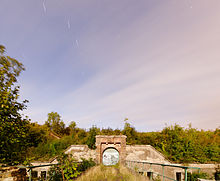- Moonlight
-
Moonlight is the light that reaches Earth from the Moon. This light does not originate from the Moon, but from sunlight. The Moon does not, however, reflect sunlight like a mirror, but it reflects light from those portions of its surface which the Sun's light strikes.[1] See diffuse reflection.
In folklore, moonlight sometimes has a harmful influence. For example, sleeping in the light of a full moon on certain nights was said to transform a person into a werewolf. The light of the moon was thought to worsen the symptoms of lunatics, and to sleep in moonlight could make one blind, or mad.[2] Nyctalopia (night blindness caused by a lack of vitamin A) was thought to be caused by sleeping in moonlight in the tropics.
Contents
Illumination
The intensity of moonlight varies greatly depending on the lunar cycle but even the full moon typically provides only about 0.2 lux illumination, so the full moon is about 500,000 times fainter than the sun. When the moon is viewed at high altitude at tropical latitudes, the illuminance can reach 1 lux.[3] The color of moonlight, particularly near full moon, appears bluish to the human eye compared to most artificial light sources. This is because of the Purkinje effect - the light is not actually tinted blue, and although moonlight is often referred to as "silvery" it has no inherent silvery quality. The Moon's albedo is 0.136,[4] meaning only 13.6% of sunlight incident on the Moon is reflected.
See also
- Daylight
- Starlight
- Earthlight (astronomy)
- Scotobiology
References
- ^ Toomer, G. J. (December 1964). "Review: Ibn al-Haythams Weg zur Physik by Matthias Schramm". Isis 55 (4): 463–465 [463–4]. doi:10.1086/349914
- ^ A Dictionary of English folklore, Oxford University Press, 2000
- ^ Bunning, Erwin; and Moser, Ilse (April 1969). "Interference of moonlight with the photoperiodic measurement of time by plants, and their adaptive reaction". Proceedings of the National Academy of Sciences of the United States of America 62 (4): 1018–1022. Bibcode 1969PNAS...62.1018B. doi:10.1073/pnas.62.4.1018. PMC 223607. PMID 16591742. http://www.pnas.org/cgi/reprint/62/4/1018. Retrieved 2006-11-10.
- ^ Matthews, Grant (2008). "Celestial body irradiance determination from an underfilled satellite radiometer: application to albedo and thermal emission measurements of the Moon using CERES". Applied Optics 47 (27): 4981. Bibcode 2008ApOpt..47.4981M. doi:10.1364/AO.47.004981. PMID 18806861.
External links
- Phases of the Moon at USNO
- Strange Moonlight at Science@NASA
- Moonlight Brightness at LunarLight Photography
Categories:- Observing the Moon
- Light
- Light sources
- Moon stubs
Wikimedia Foundation. 2010.


